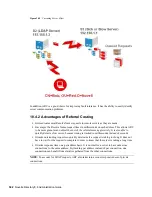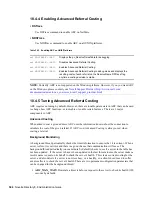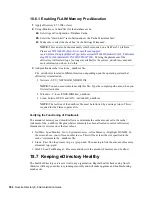
Maintaining Novell eDirectory
553
no
vd
ocx
(e
n)
6 Ap
ril 20
07
Disabling Inline Change Cache marks the change cache as invalid for this replica and tags it with an
invalid flag in
Agent Configuration
>
Partitions
. Enabling Inline Change Cache removes the invalid
change cache flag when the change cache is rebuilt.
18.5.9 Increasing the LBURP Time Out Period
By default, the time out period for a client is 20 minutes (1200 seconds). But during bulkload, with
the LBURP transaction size as high as 250, objects with large number of attributes with huge values
for these attributes, and with LBURP concurrent processing enabled at the server, the server gets
busy processing data pumped in by the ICE client without responding to the client in the stipulated
time. This times out the ICE client.
Therefore, we recommend you to increase the time out period. You can do this by exporting the
environment variable LBURP_TIMEOUT with high values (in seconds).
For example, to export the LBURP_TIMEOUT variable with 1200 seconds, enter the following:
export ICE_LBURP_TIMEOUT=1200
18.6 Countering Memory Fragmentation
A new option preallocate has been added to counter memory fragmentation.The preallocate option
changes how eDirectory makes requests to the native operating system memory manager. Prior to
873IR6, eDirectory would make multiple memory requests to the memory manager for the cache.
Thsi would increase the "size" of cache over time. Using iMonitor, the administrator could set an
upper or a hard limit. However, the administrator could not control when eDirectory would grow the
cache, i.e. make additional requests for memory.
With the release of 873IR6, the administrator would be able to control when eDirectory makes
requests for more memory by using the preallocate option. When this option is used, eDirectory
makes one memory request at startup time for the entire amount specified by the hard cache limit.
eDirectory has been enhanced to control the allocation and deallocation by the eDirectory cache of
this large memory block.
Advantage: The advantage of using the preallocate option is that the memory allocated to the
eDirectory cache will never be fragmented by the native operating system memory manager. As
eDirectory 8.7.3 is a 32 bit application, it can only access a maximum of 4Gb memory, and some
operating systems allow even less for an individual process. For instance, Red Hat AS 3.0 allows
only a maximum of 3Gb.
Prior to 873IR6, the hard cache limit had to be set to a low level, typically 500 Mb or less.If set
higher, the operating system memory manager would fragment the cache memory and the ndsd
process would keep allocating more and more memory. In some cases, this would cause the ndsd
process to crash. With 873IR6 and the preallocate option set, the hard cache limit can be set to a
higher level without producing fragmentation and the risk of an ndsd crash. With more memory
allocated to the cache, eDirectory can also perform better.
Disadvantage: The memory will always be allocated, even if never completely used. Care must be
taken to set the proper hard cache limit, especially if the eDirectory database cache is small, e.g. less
than 200 Mb.
Summary of Contents for EDIRECTORY 8.8 SP2
Page 4: ...novdocx en 6 April 2007...
Page 116: ...116 Novell eDirectory 8 8 Administration Guide novdocx en 6 April 2007...
Page 128: ...128 Novell eDirectory 8 8 Administration Guide novdocx en 6 April 2007...
Page 255: ...256 Novell eDirectory 8 8 Administration Guide novdocx en 6 April 2007...
Page 406: ...408 Novell eDirectory 8 8 Administration Guide novdocx en 6 April 2007...
Page 563: ...566 Novell eDirectory 8 8 Administration Guide novdocx en 6 April 2007...
Page 573: ...576 Novell eDirectory 8 8 Administration Guide novdocx en 6 April 2007...
Page 601: ...604 Novell eDirectory 8 8 Administration Guide novdocx en 6 April 2007...
















































